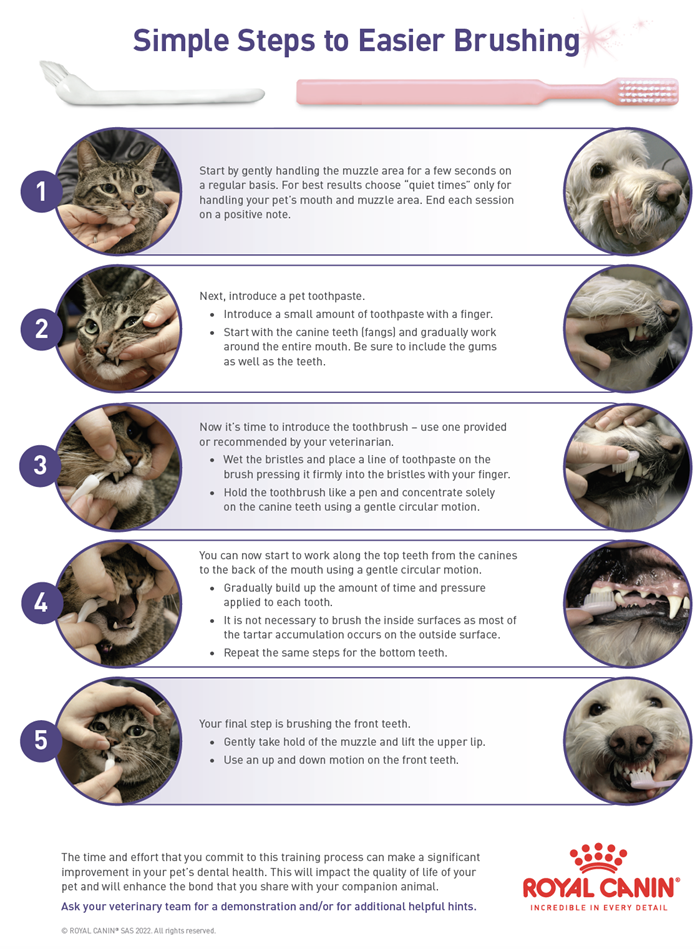Take a Bite Out of Dental Health
We all know that pets make our world a better place. They provide us with many positive things, and most of us cannot imagine our lives without our pets.
But let’s face it, as with everything, there are sometimes things we enjoy a little less about pet ownership. Maybe it’s having to pick up your pet’s poop. Maybe it’s having to vacuum up all the hair they leave around. Or maybe it’s the bad breath coming from that mouth as you try to sneak in your morning cuddles. Talk about morning breath, right?
Bad breath and dental disease are common! Up to 90% of dogs are diagnosed with dental disease, and this can have detrimental effects on the overall health of our pets! Fortunately, dental disease is also preventable and - in its early stages - reversible.
So, what can we do to reduce the risk of dental disease?
Veterinary Care
First, if you are concerned your dog has dental disease, it's time to visit your veterinarian! A good oral examination involves a preliminary assessment of the teeth, looking for signs of tartar, gingivitis, oral masses, and broken or loose teeth.
However, if you've ever tried looking in your dog's mouth, you'll know they aren't always cooperative. That is why a comprehensive oral health assessment and treatment should be performed under general anesthesia by a veterinarian. Your veterinary team can inspect all oral tissues, scale and polish the teeth, evaluate the spacing between the gums and the teeth, and perform any necessary treatment (such as removal of diseased and painful teeth).
Brushing
Have you ever experienced that fuzzy feeling on your teeth? That's plaque, which starts to form on teeth within 20 minutes of eating. Brushing helps remove plaque, which if left unchecked will harden to form tartar. You may have seen this solid, egg shell-like material on your dog's teeth. Tartar develops five times faster in dogs than it does in humans, so prevention is key!
So how often should we brush our pet's teeth? Just like in humans, daily brushing is the most effective way to help remove plaque and prevent tartar.
When should we brush? Brushing removes plaque, not tartar. If your dog has advanced dental disease and you can see tartar, brushing will not be effective in removing this hardened material. After you dog has been seen by a veterinarian and their teeth are nicely cleaned up, brushing will be an excellent step in keeping those teeth as pearly white as possible.
If possible, try to introduce brushing to puppies. Even though they do not get their adult teeth until 4-6 months of age, it is important for them to become comfortable with the process. Older dogs can also be introduced to teeth brushing, just be sure to go slowly and use lots of praise or treats to keep the experience a positive one.
For help on introducing teeth brushing to your dog, check out our step-by-step guide.

Nutrition - Diets, Chews and Other Products
While teeth brushing is one of the best things we can do to help slow down the progression of dental disease in our dogs, we know that most pet parents struggle to do this daily. In fact, almost half of pet parents never brush their dog's teeth!
As a result, many different products have emerged to help us manage the risk of dog dental disease. Oral care diets and treats can contribute to the mechanical removal of plaque through the shape, size and texture of the product. But not all chewing is equal when it comes to dental prevention! Antlers or hard chew toys such as nylon bones can fracture teeth. Check for excessive treat hardness by attempting to dent the treat with your fingernail. If you can't dent it, it's too hard for your dog's teeth!
What about kibble? If a kibble shatters the moment a dog's teeth crunches down, there will be little benefit. However, if the kibble is designed with the proper size, shape and density, the tooth will penetrate the kibble and experience a "brushing" action as the kibble glides up against the tooth surface. Diets and chews can also contain additives to help reduce the accumulation of plaque and tartar.
Arm yourselves with your toothbrushes and let's help care for our dog's teeth! By taking a few active steps, we can help keep our dogs’ mouths as fresh as possible - perfect for those morning cuddles!
References
1. Stella et al (2018). PLoSONE 13(1)
2. Dupont, GA (1998). Vet Clin North Am Sm Anim Pract 28(5)
3. Ipsos Reid (2015)